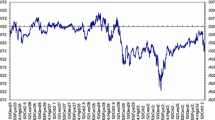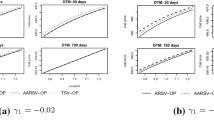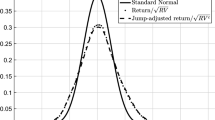Abstract
Existing evidence indicates that average returns of purchased market-hedge S&P 500 index calls, puts, and straddles are non-zero but large and negative, which implies that options are expensive. This result is intuitively explained by means of volatility risk and a negative volatility risk premium, but there is a recent surge of empirical and analytical studies which also attempt to find the sources of this premium. An important question in the line of a priced volatility explanation is if a standard stochastic volatility model can also explain the cross-sectional findings of these empirical studies. The answer is fairly positive. The volatility elasticity of calls and puts is several times the level of market volatility, depending on moneyness and maturity, and implies a rich cross-section of negative average option returns—even if volatility risk is not priced heavily, albeit negative. We introduce and calibrate a new measure of option overprice to explain these results. This measure is robust to jump risk if jumps are not priced.
Similar content being viewed by others
References
Aït-Sahalia Y., Wang Y., Yared F. (2001) Do option markets correctly price the probabilities of movement of the Underlying Asset?. Journal of Econometrics 102: 67–110
Bakshi G., Kapadia N. (2003a) Delta-hedged gains and the negative market volatility risk premium. Review of Financial Studies 16: 527–566
Bakshi G., Kapadia N. (2003b) Volatility risk premium embedded in individual equity options: Some new insights. Journal of Derivatives 11: 45–54
Bates D. (1996) Jumps and stochastic volatility: Exchange rates processes implicit in deutsche mark options. Review of Financial Studies 9: 69–107
Benzoni, L., Collin-Dufresne, P., & Goldstein, R. (2005). Can standard preferences explain the prices of out-of-the-money puts. University of Minnesota, Working Paper.
Bondarenko, O. (2003). Why are puts so expensive. University of Illinois at Chicago, Working Paper.
Branger N., Schlag C. (2008) Can tests based on option hedging errors correctly identify volatility risk premia?. Journal of Financial and Quantitative Analysis 43: 1055–1090
Broadie, M., Chernov, M., & Johannes, M. (2009). Understanding index option returns. Review of Financial Studies (forthcoming).
Buraschi A., Jackwerth J. (2001) The price of a smile: Hedging and spanning in option markets. Review of Financial Studies 14: 495–527
Cao C., Huang J.-Z. (2008) Determinants of S&P 500 index option returns. Review of Derivatives Research 10: 1–38
Carr P., Wu L. (2003) What type of process underlies options? A simple robust test. Journal of Finance 58: 2581–2610
Carr P., Wu L. (2006) A tale of two indices. Journal of Derivatives 13(3): 13–29
Carr P., Wu L. (2009) Variance risk premia. Review of Financial Studies 22: 1311–1341
Constantinides G.M., Jackwerth J.C., Perrakis S. (2009) Mispricing of S&P 500 index options. Review of Financial Studies 22: 1247–1277
Coval J., Shumway T. (2001) Expected option returns. Journal of Finance 56: 983–1009
Christoffersen, P. F., Heston, S. L., & Jacobs, K. (2007). The Shape and term structure of the index option smirk: Why multifactor stochastic volatility models work so well. University of Maryland, Working Paper.
Driessen, J., Maenhout, P., & Vilkov, G. (2009). The price of correlation risk: Evidence from equity options. Journal of Finance (forthcoming).
Duffee G. (2002) Term premia and interest rate forecasts in affine models. Journal of Finance 57: 405–443
Duffie D. (2001) Dynamic asset pricing theory (3rd ed). Princeton University Press, Princeton, New Jersey
Duffie D., Pan J., Singleton K. (2000) Transform analysis and asset pricing for affine jump-diffusions. Econometrica 68: 1343–1376
Eraker B., Johannes M., Polson N. (2003) The impact of jumps in volatility and returns. Journal of Finance 58: 1269–1300
Figlewski S., Green T.C. (1999) Market risk and model risk for a financial institution writing options. Journal of Finance 54: 1465–1499
Garleanu, N., Pedersen, L. H., & Poteshman, A. (2009). Demand-based option pricing. Review of Financial Studies (forthcoming).
Heston S. (1993) A closed-form solution for options with stochastic volatility with applications to bond and currency options. Review of Financial Studies 6: 327–344
Ibáñez A. (2008) Factorization of European and American option prices under complete and incomplete markets. Journal of Banking and Finance 32: 311–325
Jiang G.J., Tian Y.S. (2005) The model-free implied volatility and its information content. Review of Financial Studies 18: 1305–1342
Jones C. (2006) A nonlinear factor analysis of S&P 500 index options returns. Journal of Finance 41: 2325–2363
Liu J., Pan J. (2003) Dynamic derivative strategies. Journal of Financial Economics 69: 401–430
Low B.S., Zhang S. (2005) The volatility risk premium embedded in currency options. Journal of Financial and Quantitative Analysis 40: 803–832
Merton R. (1998) Applications of option-pricing theory: Twenty-five years later. The Nobel prize in economics lecture. American Economic Review 88: 323–349
Naik V., Lee M. (1990) General equilibrium pricing of options on the market portfolio with discontinuous returns. Review of Financial Studies 3: 493–521
Nandi S. (1998) How important is the correlation between returns and volatility in a stochastic volatility model? Empirical evidence from pricing and hedging in the S&P 500 index options market. Journal of Banking and Finance 22: 589–610
Pan J. (2002) The jump-risk premia implicit in options: Evidenced from an integrated time-series study. Journal of Financial Economics 63: 3–50
Santa-Clara, P., & Saretto, A. (2009). Option strategies: Good deals and margin calls. Journal of Financial Markets (forthcoming).
Wu, L. (2007). Variance dynamics: Joint evidence from options and high-frequency returns. Baruch College, Working Paper.
Author information
Authors and Affiliations
Corresponding author
Rights and permissions
About this article
Cite this article
Ibáñez, A. The cross-section of average delta-hedge option returns under stochastic volatility. Rev Deriv Res 11, 205–244 (2008). https://doi.org/10.1007/s11147-009-9030-9
Published:
Issue Date:
DOI: https://doi.org/10.1007/s11147-009-9030-9
Keywords
- Average delta-hedged option returns
- Stochastic volatility
- Volatility risk premium
- Option returns and option prices
- Incomplete markets




